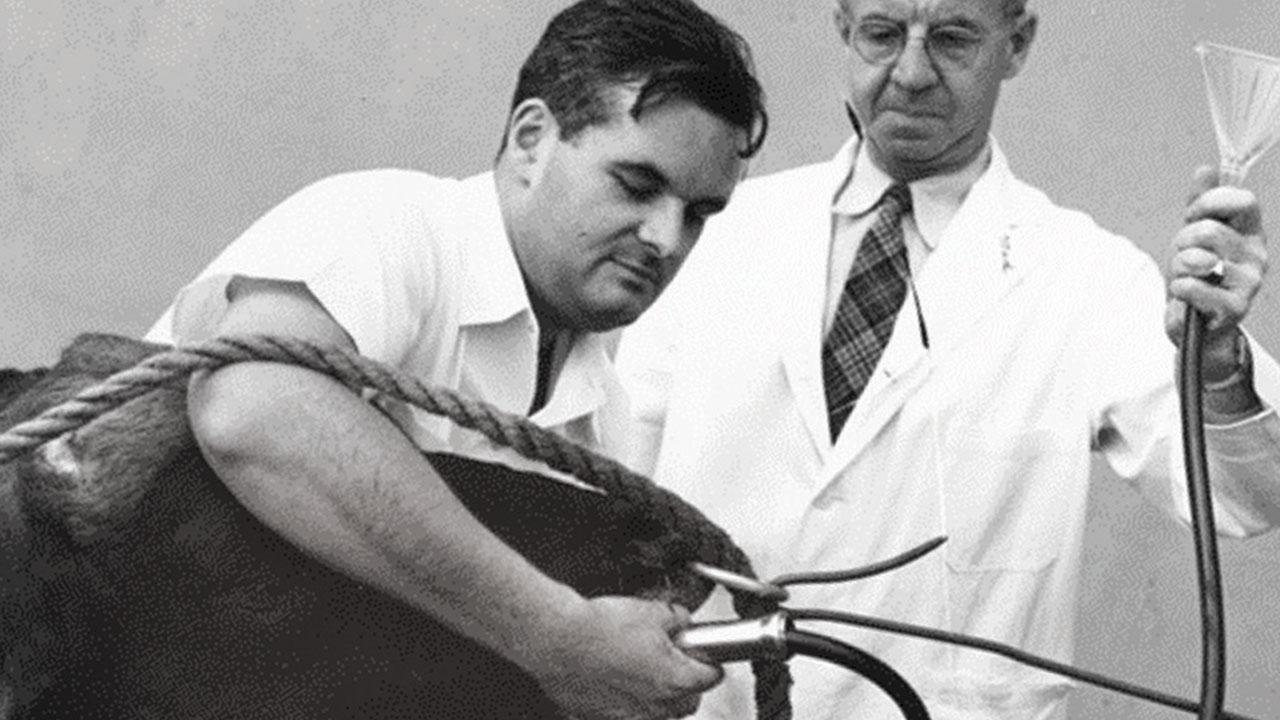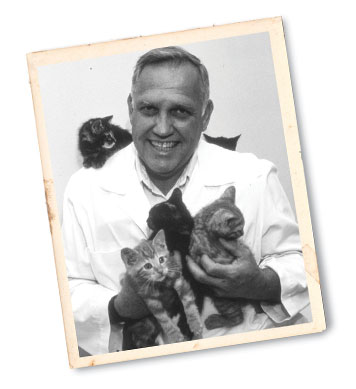
Top Clinical & Research Accomplishments Over 75 Years
Since 1948, the school’s faculty, staff, and students have made significant breakthroughs in research studies and clinical applications—from vaccine development for devastating livestock diseases to using stem cells in regenerative medicine. Their work has changed the world and laid the groundwork for future veterinarians to expand on their advances. On the 75th anniversary of the school’s opening, we celebrate those achievements by highlighting several key accomplishments.


Optimizing Livestock Health
When the UC Davis School of Veterinary Medicine was initially established, improving livestock health through research and clinical care was of paramount concern. Several significant breakthroughs occurred in livestock health, including:
- The first intradermal skin test for bovine tuberculosis was developed and helped reduce bovine TB to less than two-tenths of one percent in U.S. cattle. Research of a vaccine’s efficacy led to almost universal use of this immunization to help control brucellosis, a contagious disease that can wipe out entire herds of livestock.
- In 1954, the school created the first of several vaccines to combat bluetongue virus, an infectious sheep disease. Ongoing research produced a more effective enzyme-linked immunoassay diagnostic test in 1990 and an improved vaccine, along with a better understanding of the environmental and economic impacts of bluetongue on the international livestock trade.
- Blood-typing services for livestock owners and breed associations were initiated in 1955. Services have evolved into DNA-based technology for many species to identify individual animals, verify parentage, and detect inherited diseases or other traits.
- Fifty years of research into foothill abortion (epizootic bovine abortion)— first recognized in California in the 1930s— facilitated a better understanding of the disease and culminated in veterinary scientists developing a vaccine that became commercially available in 2020. Throughout the decades, foothill abortion resulted in the death of tens of thousands of calves annually and was a major economic burden for Western beef producers. The tick-transmitted bacterial disease affects pregnant cattle that graze in the foothill or mountainous regions of California, Northern Nevada, and Southern Oregon.
-
Faculty determined in 1974 that Pasteurella bacteria was the source of pneumonia that was causing the majority of cattle deaths in feedlots. The finding led to better industry standards for beef cattle health and well-being.
-
The school opened the Veterinary Medicine Teaching and Research Center in Tulare in 1983 to conduct applied research at the hub of the U.S. dairy and beef industry. The creation of the J-5 mastitis vaccine in 1998 came from this venture, improving animal health and saving dairy producers $11 million annually. The center also offers unique opportunities for specialized training and provides comprehensive veterinary services to regional dairy clients.
- In 1990, faculty identified the Neospora parasite as the major cause of abortion in dairy cattle, which was causing the cattle industry an estimated $35 million a year.
- In 2006, the school partnered with Lawrence Livermore National Laboratory, the U.S. Department of Homeland Security, and the U.S. Department of Agriculture to develop a rapid diagnostic test that simultaneously tests for foot- and-mouth disease (FMD) and six other look-alike diseases in livestock. The new test reduces the period for diagnosing all seven diseases from days to hours.
- If an outbreak occurred in the U.S., it is estimated that up to $3 million in direct costs would be lost for every hour’s delay in diagnosing FMD.
Since 1948, the school’s faculty, staff, and students have made significant breakthroughs in research studies and clinical applications.


Combating Newcastle Disease
In 1948, faculty researching Newcastle disease in chickens worked with colleagues at the California Department of Fish & Game (now Wildlife) to determine that virus particles can be recovered from the air as a result of natural infection. The team developed methods for diagnosis and mass immunization by aerosol vaccination, preventing heavy losses in flocks throughout California and other states. Over the decades, this would prove extremely valuable to poultry producers. In 2003, Veterinary Medicine Extension and California Animal Health and Food Safety Laboratory faculty members helped a U.S. Department of Agriculture task force curtail an outbreak of exotic Newcastle disease. Faculty built trust with backyard bird enthusiasts, while laboratory specialists developed sophisticated informatics to track the outbreak in real time. New cases were quickly identified, and researchers developed a rapid diagnostic test that prevented unnecessary destruction of flocks. Due to these efforts, the outbreak was contained two years sooner than expected, saving poultry producers more than $500 million.

Advancing Immunodeficiency Virus Research
In the early 1980s, medical and veterinary school researchers at the UC Davis California National Primate Research Center investigated an unusual outbreak of immune deficiency that was occurring in a group of rhesus monkeys housed at the center.

At about the same time, a new and deadly disease was appearing around the world in humans that would become known as acquired immune deficiency syndrome (AIDS). In 1984, UC Davis researchers demonstrated that the immune deficiency disorder in the rhesus monkeys resulted from an infectious agent, named simian retrovirus. This led to the identification of another retrovirus, simian immunodeficiency virus. By the early 1990s, UC Davis veterinary researchers identified a similar viral disease in cats, which would become known as feline immunodeficiency virus. These are the earliest animal models for AIDS research and were used to study treatments and vaccines for HIV/AIDS.

Curing Feline Infectious Peritonitis
Following 50 years of research by UC Davis veterinary scientists, the antiviral drug GS-441524 was discovered to be a cure for feline infectious peritonitis (FIP) in 2019. Up to 95% of cats diagnosed with FIP die without treatment.

Cats can develop FIP at any age, but it is usually diagnosed in cats between 6 months and 2 years of age. It is one of the most common causes of death in young cats. Unfortunately, the manufacturer of GS-441524 chose not to market the drug for veterinary purposes, even though thousands of cats with FIP worldwide have been successfully treated with a black-market version of the drug in the past three years. Currently, there remains no successful treatment approved for veterinarians in the U.S., but UC Davis continues its research with new clinical trials of GS-441524 and other treatment applications.

Leading Renal Medicine
For nearly 50 years, UC Davis has been a leader in renal medicine with its early development of hemodialysis in the 1970s and 1980s and its ongoing advancement to the present.

UC Davis established the world’s first hemodialysis and extracorporeal center in 1993 and the first advanced training programs for extracorporeal therapies (hemodialysis, hemoperfusion, and therapeutic apheresis) in 1995. For the next two decades, UC Davis was one of only a handful of veterinary facilities worldwide to offer advanced extracorporeal medicine. It remained the only program in California until the creation of the second UC Davis extracorporeal program at the UC Veterinary Medical Center-San Diego in 2000. In 2014, the UC Davis Hemodialysis Academy was established, delivering instruction on the theory and applications of hemodialysis and extracorporeal therapies to more than 600 veterinarians from 32 countries. Today, UC Davis is recognized as the most iconic and advanced extracorporeal therapies program worldwide.

Setting Genetic Testing Standards
The Veterinary Genetics Laboratory (VGL) was established in 1955 to verify parentage for cattle registries. For the next 70 years, VGL set the standard for excellence in veterinary genetic testing. The laboratory now provides testing for more than 20 species, while also contributing to education and research. In the early 1990s, VGL became one of the first laboratories to use DNA markers for parentage verification. Shortly thereafter, the discovery of genetic causes for heritable disorders was unraveled, making DNA testing available for diagnostic purposes.

In the past decade, advanced tools have accelerated the discovery of genetic variants behind traits of interest, enabling marker- assisted mate selection and providing tools to inform clinical management decisions. Today, the VGL offers more than 220 genetic tests for various coat color and production traits, genetic disorders, and parentage verification of several animal species to clients around the world.

Critically Improving Feline Nutrition
In 1987, UC Davis veterinary cardiologists and nutritionists discovered a link between feline dilated cardiomyopathy (DCM) and a lack of dietary taurine, an essential amino acid in cats, in conventional pet foods. The research resulted in multiple initial descriptions of essential amino acids in the feline diet and how nutrition affects the health of cats, ultimately leading to the supplementation of commercial feline diets with adequate taurine. Non-hereditary feline DCM was common in the overall cat population prior to this discovery but has since become a rarely seen disease in properly nourished cats. Adding taurine to commercial cat foods reversed the problem and saved thousands of cats’ lives.


Pioneering Surgical Techniques
In 1950, the placement of pins in fractured bones was first described at UC Davis. Used for more than 20 years, this method was the precursor to more modern techniques. Many other surgical procedures and instruments were developed at the school during that era, including the first surgery of a shoulder muscle, a novel repair of a dog’s ruptured anterior cruciate ligament, and the first practical total hip replacement—an early One Health effort before the term “One Health” existed due to a collaboration of veterinary surgeons, physicians, and engineers. These innovations created the framework for cutting-edge orthopedic surgeries being performed today, including custom 3D-printed titanium hip replacements.



Educating Veterinary Specialists
In 1968, the groundwork was laid for the first veterinary training programs in the impending 1970 opening of the Veterinary Medical Teaching Hospital (VMTH), the first of its kind in the U.S. Soon after, residencies were established in many disciplines, including internal medicine, emergency medicine, avian medicine, anesthesiology, dermatology, zoological medicine, behavior, and many others. These innovative programs at the VMTH set milestones in advanced training programs for residents and led to the modern-day House Officer Program at UC Davis, the largest veterinary training program in the nation. Annually, more than 120 veterinarians now train in residencies, fellowships, and internships in more than 35 specialty disciplines. To this day, the VMTH remains the gold standard of teaching hospitals and is one of the largest veterinary hospitals in the world.
The UC Davis veterinary hospital hosts the largest residency training program in the world in more than 35 specialties.

The Power of Regenerative Medicine
The advancement of regenerative medicine— the application of stem cell biotechnology or tissue engineering to aid in the repair of injured tissue—has taken veterinary medicine to new heights over the past two decades and is foreshadowing the future of injury repair in humans. Oral and orthopedic surgeons are realizing the full potential of bone morphogenetic protein to regrow dog jaw and leg bones; neurosurgeons are pioneering a stem cell treatment for spina bifida in bulldogs that led to a world’s first application of an in-vitro treatment for the disease in babies; equine lameness specialists are utilizing stem cells to repair ligament damage in racehorses, which may hold similar healing powers for injuries in human athletes; and feline chronic gingivostomatitis (which affects as many as 1 in 7 cats) is being cured thanks to a stem cell therapy that may soon be available as a packaged treatment product. The school’s Veterinary Institute for Regenerative Cures and the Veterinary Center for Clinical Trials are moving these and other initiatives forward, as the future of veterinary medicine is being shaped at UC Davis.
* Historical images courtesy of University Archives, University of California.
